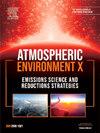利用无人机探测研究垃圾焚烧炉烟气和垃圾填埋场排放的挥发性有机化合物
IF 3.4
Q2 ENVIRONMENTAL SCIENCES
引用次数: 0
摘要
焚烧是一种废物处理方法,涉及燃烧废物的有机成分。虽然这一过程大大减少了送往垃圾填埋场的废物量,但它也造成环境污染,并对公众健康构成潜在风险。虽然对某些燃烧过程排放的挥发性有机化合物(VOCs)进行了研究,但很少对焚化炉烟囱中以空气羽流形式释放的VOCs进行评估。这种知识差距主要是由于缺乏准确探测和捕获烟囱羽流的适当观测技术。在这项研究中,我们采用新颖的无人机观测和采样技术来研究垃圾焚烧烟囱排放的特征挥发性有机化合物。此外,我们分析了垃圾填埋场的挥发性有机化合物排放量,以提供比较评估。研究结果表明,焚化炉烟气中乙烷、丙烷、乙炔、苯、丙酮、甲基乙基酮和苯甲醛的含量较高,而壬醛和癸醛主要来自垃圾填埋场。另一种令人感兴趣的物质是三甲基硅醇(TMSiOH),在焚化炉烟尘和垃圾填埋场排放物中都观察到其浓度特别高。这些来源的TMSiOH水平明显高于城市、农村、路边和背景大气环境中检测到的TMSiOH水平,突出了其作为焚化炉烟雾和垃圾填埋场排放的特征标记物识别污染源的潜力。总体而言,本研究表明,基于无人机(UAV)的探测能够实时探测空中羽流,并表征焚化炉羽流和垃圾填埋场排放。此外,我们建议TMSiOH作为焚烧炉羽流和垃圾填埋场排放的潜在标记物,这可能为识别污染源提供重要帮助。本文章由计算机程序翻译,如有差异,请以英文原文为准。

A study of VOCs in waste incinerator plumes and landfill emissions via drone sounding
Incineration is a waste treatment method that involves burning the organic components of waste. While this process significantly reduces the volume of waste sent to landfills, it also generates environmental pollution and poses potential risks to public health. Although volatile organic compounds (VOCs) emitted from some combustion processes have been studied, VOCs released in the form of aerial plumes from incinerator smokestacks have rarely been evaluated. This knowledge gap is primarily due to the lack of suitable observation techniques for accurately detecting and capturing smokestack plumes. In this study, we employed novel drone-based observation and sampling techniques to investigate the characteristic VOCs emitted from a waste incineration smokestack. Additionally, we analyzed VOC emissions from landfills to provide a comparative assessment. Our findings indicate that incinerator plumes presented higher proportions of ethane, propane, ethyne, benzene, acetone, methyl ethyl ketone, and benzaldehyde, while nonanal and decanal originated mainly from landfills. Another species of interest is trimethylsilanol (TMSiOH), which has been observed in particularly high concentrations in both incinerator plumes and landfill emissions. TMSiOH levels from these sources were significantly higher than those detected in urban, rural, roadside, and background atmospheric environments, highlighting its potential as a characteristic marker of incinerator plumes and landfill emissions to identify pollution sources. Overall, this study demonstrates that unmanned aerial vehicle (UAV)-based sounding enables real-time detection of aerial plumes and characterization of incinerator plumes and landfill emissions. In addition, we proposed TMSiOH as a potential marker for incinerator plume and landfill emissions, which may provide important assistance in identifying pollution sources.
求助全文
通过发布文献求助,成功后即可免费获取论文全文。
去求助
来源期刊

Atmospheric Environment: X
Environmental Science-Environmental Science (all)
CiteScore
8.00
自引率
0.00%
发文量
47
审稿时长
12 weeks
 求助内容:
求助内容: 应助结果提醒方式:
应助结果提醒方式:


